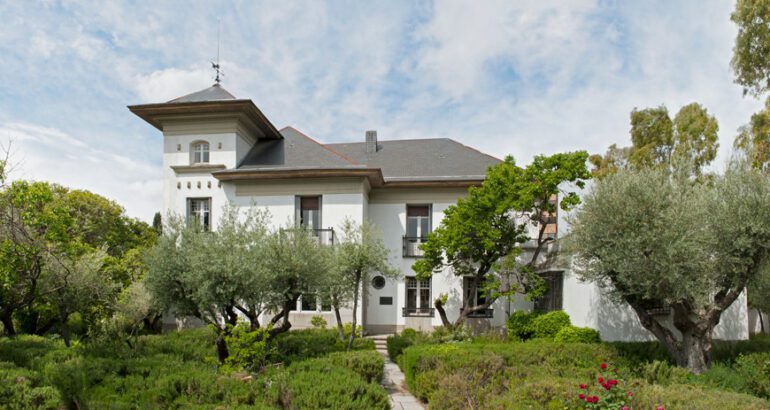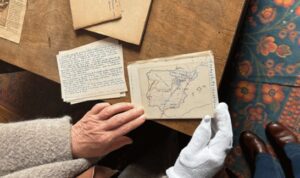
New Book “Educadoras y feministas entre España y América. Nuevos horizontes pedagógicos 1872-1990”
In the autumn of 2023, a cycle of conferences titled Educadoras y Feministas Entre España y América: Nuevos Horizontes Pedagógicos took place at the International Institute. These conferences, born of the ongoing collaboration between the Fundación Ramón Menéndez Pidal and the International Institute, delved thoroughly into the female educators of Spain’s Silver Age.
This past December, the two institutions published Educadoras y feministas entre España y América. Nuevos horizontes pedagógicos 1872-1990 as a continuation of their collaboration. The book, written by six female researchers, illuminates the fruitful relationships between these reformers from both sides of the Atlantic.
“It has been dedicated to six women that are already known,” said Elena Gallego, one of the book’s editors. “But it explores further what relationship existed between them, between the American pedagogy and the Spanish ideas of the Silver Age.”
The beginnings
Just a day after her wedding in 1871, Bostonian Alice Gordon Gulick boarded Siberia, a boat which would eventually take her to Spain. She and her husband had embarked on a missionary journey, unaware that it was the beginning of a transformative educational experience.
Settling in Santander, the couple immersed themselves in their missionary work until 1877, when Gulick opened her house to a small number of students.
Gulick had no idea that this humble classroom would eventually grow into the International Institute, a center for language and cultural learning that spans between Spain and the United States. Her ambition to provide Spanish girls with a rigorous education would spark a movement, attracting professors from leading female colleges in the U.S. and challenging the very nature of female education in Spain.
As the school thrived, it moved to San Sebastián and became the North American School, where the exchange of progressive educational ideas flourished. Alice’s vision of reforming Spanish education began to take shape, supported by like-minded thinkers such as Gumersindo Azcárate, Francisco Giner and Manuel Cossío. Encouraged by their support, the couple relocated the school to Madrid in 1901.
Gulick and the feminist educators who followed her modernized the Spanish education system. Because of their educational labor, Spanish women and girls could participate in academic life like never before.
The work of feminist educators across the Atlantic between 1872 and 1990 in initiatives such as the International Institute, the Residencia de Señoritas and the Instituto-Escuela made girls’ education in Spain more accessible and comprehensive.
Although Gulick started the institution later known as the International Institute, it was Susan Huntington who transformed the education center, introducing school levels from preschool to the end of high school years.
Born in Norwich, Connecticut, in 1869, Huntington graduated from Wellesley College in 1900. She became director of the Institute in 1910 and maintained the position until 1918.
Part of Huntington’s work at the Institute was her decision to open the doors to a more diverse student body, moving it away from its significant protestant roots. This, combined with new programs that spanned across all pre-university levels, caught the attention of Spanish educators and intellectuals, including José Ortega y Gasset, Rafael Altamira, Juan Ramón Jiménez, Manuel Gómez Moreno and Ramón Menéndez Pidal.
In 1917 the Institute collaborated with the Board for the Extension of Studies to bring to fruition two of its projects: the Instituto-Escuela and the Residencia de Señoritas.
The Institute supported the programs by providing teachers and ceding its facilities. It also oversaw the girls boarding school at the Instituto-Escuela, taught English classes and organized sports and games.
Educational reforms
The success of these women was driven by the growing demand for equal education at the time.
“Until well into the 20th century, there was a huge difference in opportunities that young Americans had at their disposal in the field of education compared to those of Spanish women,” said Pilar Piñón, the executive director of the Institute and the book’s other editor.
In 1900 there were just nine women registered in the Spanish Universities, according to an article by Consuelo Fecha García, professor of the history of education at the University of Sevilla. By 1936, the number of female students had risen to 2,588.
This change reflects both a growing interest in female education and more access to institutions that could adequately prepare them for university, according to Fecha García.
The educational disparity between the U.S. and Spain was a key factor in why the American educators who came to Spain were able to make such valuable contributions. Piñón noted, “Those women who came to Spain were doctors, had a brilliant academic career, had traveled—they were a paradigm of the modern woman.”
The International Institute and the Residencia de Señoritas sought to fill the gaps left by the Spanish university system by offering a chemical laboratory in the early 1920s. They also organized the first library science courses in Madrid in 1928. The Institute continued to offer these courses for 50 years.
Another foundational figure in education in Spain was María Goyri, who played an integral role in launching the Instituto Escuela in 1918, according to her biography. Goyri aimed to modernize education in Spain by following in the teaching style of previous institutions, including the revolutionary Institución Libre de Enseñanza.

Gallego, director of the educational archive of the Fundación Ramón Menéndez Pidal, explained during the interview that María Goyri’s students copied their lessons onto notecards, incorporating maps, drawings and photographs in order to visualize the content they learned. The students learned science, literature and history, not through traditional textbooks, but with the help of these cards they made themselves.
While Goyri taught students and trained professors at the Instituto-Escuela, her daughter, Jimena Menéndez Pidal, later joined the program as a professor of sports and games.
The first two decades of Francisco Franco’s dictatorship focused heavily on rejecting the modern advances made during Spain’s liberal beginning of the century, according to an article by António Canales, a professor and specialist in the history of education under the Franco dictatorship at the Universidad Complutense de Madrid.
According to the Library of Education, Franco’s administration dissolved the Instituto-Escuela in 1940. Despite this, Menéndez Pidal, along with Carmen García del Diestro and Ángeles Gasset, created a new educational center with the same teaching methods: the Colegio Estudio.
Gallego said Menéndez Pidal showed bravery in her defiance of the regime´s restrictions.
“They did not renounce any of their ideals, and they succeeded,” Gallego said. “For example, coeducation, which had been completely prohibited since the 1940s.”
Menéndez Pidal insisted on co-educating boys and girls in the Colegio Estudio in spite of the regulations prohibiting it. When Francoist inspectors arrived to ensure the school followed gender divisions, teachers notified the students and they quickly changed classes to pretend as though they had been learning in separate classrooms all along.
Legacies
Gallego explained that even when more women were incorporated into the universities, they were an absolute minority. Male university students and staff frequently mistreated and misunderstood them.
“Women have always been left in a secondary place,” Gallego said.
The women from the Silver Age—spanning from the late 19th century to the end of the Spanish Civil War—were largely invisible to society from the 1940s onward. Despite their remarkable achievements as writers, educators, jurists, and scientists, many were overlooked, their work forgotten or misattributed to men, including members of the influential Generation of ’27 .
Franco’s dictatorship only worsened that inferiority. During the decades of the dictatorship, the names of these female educators were hidden and forgotten, according to Gallego. In recent years, however, there’s been a shift: more teachers are educating their students about the vital contributions of these women and the institutions they helped create.
“Fortunately, in recent decades, universities have begun to revalue studies on these women, who had excellent academic training. There are new generations of students and university women have begun to investigate these figures and bring them to light.” Gallego said.
Gallego said she believed the values these women lived by and promoted remain relevant today, especially coexistence. She pointed to the relationship that existed between women such as Jimena Menéndez Pidal, Ángeles Gasset, Carmen Garcia del Diestro, Susan Huntington, Mary Sweeney, and many other great American professors.
“A very respectful, very pleasant, very proper coexistence was established between them,” Gallego said. “In Spain, it wasn’t common.”
Furthermore, institutions such as the Ramón Menéndez Pidal Foundation and the International Institute in Spain maintain a lasting legacy between the United States and Spain in terms of education. In the case of the International Institute, more than a thousand students attend courses in its building each year.
Publications, like the joint work between these two institutions, contribute to giving visibility to the legacies of women from these periods, inspiring new generations to continue the fight for equality.
By Abbey Mulcahy.



